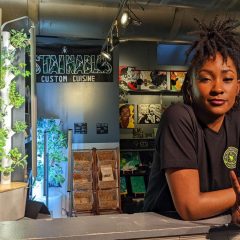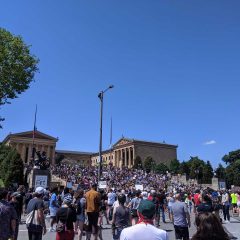Post by Andrea Kirsh

Michelle Wilson’s El Processo installation
Rumor has it that the internet will put books out of business, but I don’t believe it. But I wonder whether that’s why book arts students are producing work that could readily be described as installations, sculpture … anything but books. Are they hedging their bets? I should have thought that the one characteristic that book arts and printmaking will always share is multiplicity – but no, not even that showed up in the work I saw at the MFA thesis exhibition of U Arts’ Book Arts and Printmaking students, at the Rosenwald-Wolf Gallery (through April 30; four further students will exhibit after then). The work was very good, but if I had to describe it I’d say that there were two book arts students, a sculptor and one student of fiber arts. Not that labels matter.

A detail of Graham Watson’s scroll
Graham Watson’s work is clearly book-making: he showed “Chronograph,” an elegant codex bound in white leather. Its pages contained text as well as attached inserts that rotated, like time-pieces. The paper was perforated in patterns so that one page showed through another, emphasizing both the three-dimensionality of the book as well as its progressive nature. He also exhibited a large scroll with photographic imagery, a soft-bound book and a number of photographs on the walls.

Detail of Michelle Wilson’s El Progresso installation
Michelle Wilson’s “El Proceso” is an installation that grows out of a large book which interweaves the story of its own making with a tale of endangered birds. The binding of each signature punctuates the story, where the birds are metaphors for the “disappeared” victims of Argentina’s military regime. In the installation the pages break free of the book and float upwards, where they morph into birds. Printmaking has a long history of representing man’s inhumanity: Callot’s 17th-century “Misery of War,” which inspired Goya’s 19th-century “Disasters of War.” It’s a subject that, unfortunately, is always current. Wilson’s is a beautiful, if tragic meditation on the place of art in commemorating loss and embodying memory.

detail of Chronograph, by Phuong Pham (4/25/2007 oops, this piece is Locus–see comment below)
Phuong Pham showed a group of hangings made of transparent white silk to which she had stitched a variety of substances: nail-clippings, horsehair and beads. I was told that the works embody her family’s story of dislocation and immigration. The stitches which attached the nail-clippings made the silk ripple, creating the impression of very wet watercolor which distorts the paper. The horsehair almost read as drawing in three dimensions. These works are delicate and extremely sensual; the silk is so fine that it moves with one’s breath. My favorite piece is narrow and very tall, with cascading hair that might be Rapunzel’s.

Elena Bouvier and her work Self Contained
In the back room Elena Bouvier showed two large wall pieces, both multi-part and with integral lighting. “Self Contained” has several shelves of jars, each containing visible contents and attached illumination, as if to aid some chemical process. The brightly-colored and slightly loopy assemblage appears to have come from an alchemist’s workshop. “Under Foot” is much more restrained: a wall arrangement of back-lit photographs of man-hole covers, each set into a small box (with visible vestiges of their origins as cigar boxes). The format is very close to Christian Boltanski’s work, but lacking his tragic historical associations.
–Andrea Kirsh is an art historian based in Philadelphia. You can read her newest Philadelphia Introductions and other commentary at InLiquid.









